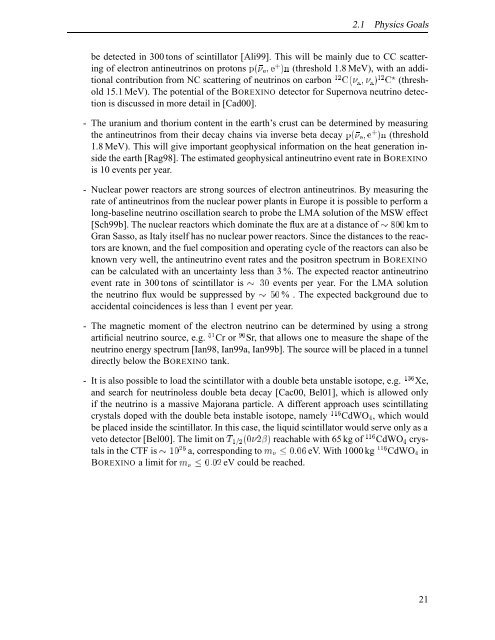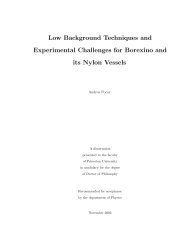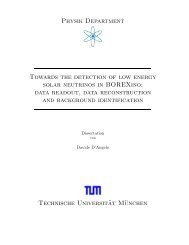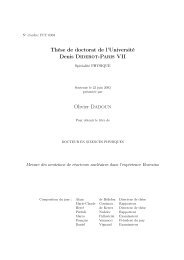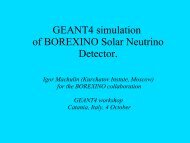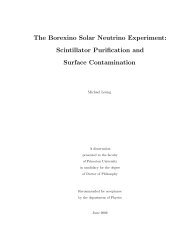Development of a Liquid Scintillator and of Data ... - Borexino - Infn
Development of a Liquid Scintillator and of Data ... - Borexino - Infn
Development of a Liquid Scintillator and of Data ... - Borexino - Infn
Create successful ePaper yourself
Turn your PDF publications into a flip-book with our unique Google optimized e-Paper software.
2.1 Physics Goals<br />
be detected in 300 tons <strong>of</strong> scintillator [Ali99]. This will be mainly due to CC scattering<br />
<strong>of</strong> electron antineutrinos on protons Ô Ò (threshold 1.8 MeV), with an additional<br />
contribution from NC scattering <strong>of</strong> neutrinos on carbon ÜÜ (threshold<br />
15.1 MeV). The potential <strong>of</strong> the BOREXINO detector for Supernova neutrino detection<br />
is discussed in more detail in [Cad00].<br />
- The uranium <strong>and</strong> thorium content in the earth’s crust can be determined by measuring<br />
the antineutrinos from their decay chains via inverse beta decay Ô Ò (threshold<br />
1.8 MeV). This will give important geophysical information on the heat generation inside<br />
the earth [Rag98]. The estimated geophysical antineutrino event rate in BOREXINO<br />
is 10 events per year.<br />
- Nuclear power reactors are strong sources <strong>of</strong> electron antineutrinos. By measuring the<br />
rate <strong>of</strong> antineutrinos from the nuclear power plants in Europe it is possible to perform a<br />
long-baseline neutrino oscillation search to probe the LMA solution <strong>of</strong> the MSW effect<br />
[Sch99b]. The nuclear reactors which dominate the flux are at a distance <strong>of</strong> km to<br />
Gran Sasso, as Italy itself has no nuclear power reactors. Since the distances to the reactors<br />
are known, <strong>and</strong> the fuel composition <strong>and</strong> operating cycle <strong>of</strong> the reactors can also be<br />
known very well, the antineutrino event rates <strong>and</strong> the positron spectrum in BOREXINO<br />
can be calculated with an uncertainty less than 3 %. The expected reactor antineutrino<br />
event rate in 300 tons <strong>of</strong> scintillator is events per year. For the LMA solution<br />
the neutrino flux would be suppressed by % . The expected background due to<br />
accidental coincidences is less than 1 event per year.<br />
- The magnetic moment <strong>of</strong> the electron neutrino can be determined by using a strong<br />
artificial neutrino source, e.g. Cr or Sr, that allows one to measure the shape <strong>of</strong> the<br />
neutrino energy spectrum [Ian98, Ian99a, Ian99b]. The source will be placed in a tunnel<br />
directly below the BOREXINO tank.<br />
- It is also possible to load the scintillator with a double beta unstable isotope, e.g. Xe,<br />
<strong>and</strong> search for neutrinoless double beta decay [Cac00, Bel01], which is allowed only<br />
if the neutrino is a massive Majorana particle. A different approach uses scintillating<br />
crystals doped with the double beta instable isotope, namely CdWO, which would<br />
be placed inside the scintillator. In this case, the liquid scintillator would serve only as a<br />
veto detector [Bel00]. The limit on Ì ¬ reachable with 65 kg <strong>of</strong> CdWO crystals<br />
in the CTF is a, corresponding to Ñ eV. With 1000 kg CdWO in<br />
BOREXINO a limit for Ñ eV could be reached.<br />
21


